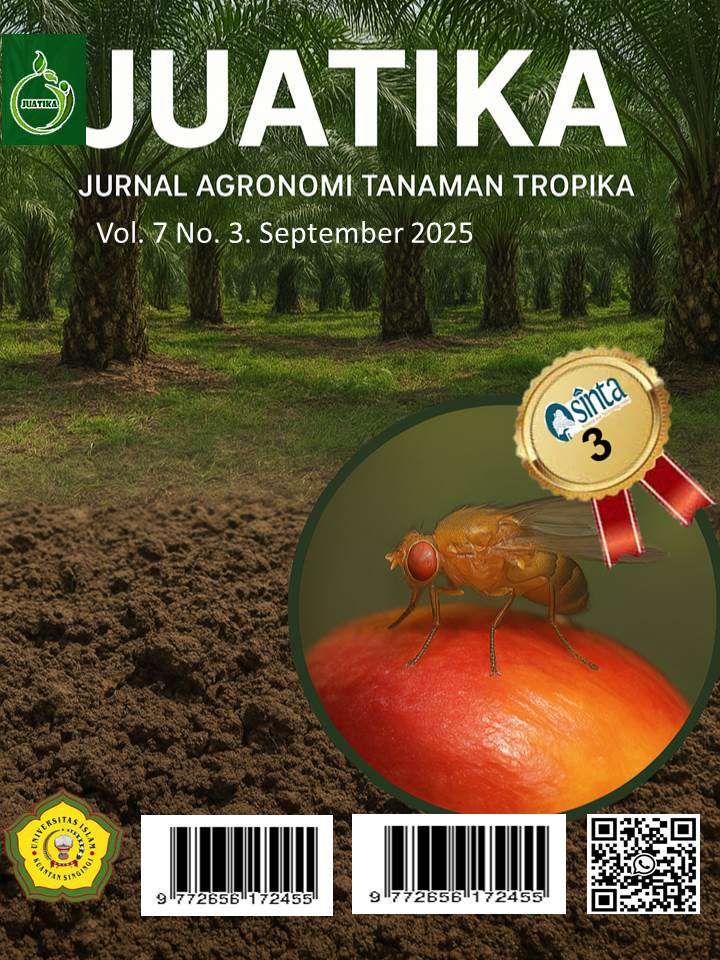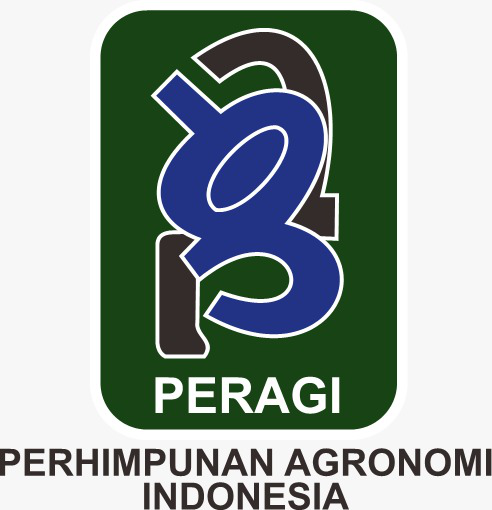The Effectiveness of Rorak in Increasing Arabica Coffee (Coffea arabica L.) Growth and Productivity in the Gayo Highlands Bener Meriah Regency
Abstract
Arabica coffee plants can only grow optimally at altitudes above 1,000 meters above sea level. This research aims to compare the growth and yield of Arabica coffee plants (Coffea arabica) on land with and without Rorak at the Testing and Implementation Installation of Standard Agricultural Instruments (IP2SIP) in Gayo Regency, Aceh. The study uses a descriptive quantitative method with purposive sampling, involving 50 plant samples from two gardens. Growth parameters observed include stem diameter and leaf area, while yield parameters include fruit diameter and fruit weight. The results show that plants grown on land with Rorak exhibit significantly different growth compared to those on land without Rorak. Stem diameter and leaf area are larger on land with Rorak, indicating more optimal physiological conditions and vegetative development. Regarding yield parameters, fruit diameter and fruit weight are also higher on land with Rorak, reflecting better seed formation and more complete fruit filling. Overall, the implementation of Rorak in Arabica coffee plantations has the potential to enhance vegetative growth and plant productivity, making it an effective practice for sustainable cultivation systems in highland areas. Reason: The text was revised to correct grammar, punctuation, and spelling errors, improve sentence structure, and enhance clarity and technical accuracy. The vocabulary was refined to convey the research objectives, methods, and findings more effectively, ensuring the text is coherent and professional for an academic audience.
Downloads
References
Dirjenbun. (2024). Statistik perkebunan unggulan nasional (hlm. 1–572). Direktorat Jenderal Perkebunan.
Fauzi, I., Sulistyawati, & Purnamasari, R. T. (2021). Pengaruh dosis pupuk nitrogen pada pertumbuhan dan hasil tanaman sawi (Brassica juncea L.) varietas Samhong King. Jurnal Agroteknologi Merdeka Pasuruan, 5(2), 37–43.
Haryanto. (2019). Pelatihan budidaya berkelanjutan (Good Agriculture Practice – GAP) dan pascapanen (Post-Harvest) kopi arabika. Badan Penyuluhan dan Pengembangan SDM Pertanian Kementerian Pertanian.
Hutasoit, J., & Hanum, C. (2015). Kadar N tanah dan daun serta klorofil karet umur sembilan tahun dengan penempatan mulsa vertikal pada rorak. Jurnal Agroekoteknologi Universitas Sumatera Utara, 3(4), 105848.
Nugroho, P. A. (2017). Pembangunan rorak dan aplikasi tankos di areal perkebunan karet (The study of silt pits establishment and empty fruit bunch application in rubber plantation). Inovasi, 14(2), 155–161.
Pratiwi, P., & Salim, A. G. (2013). Aplikasi teknik konservasi tanah dengan sistem rorak. Jurnal Penelitian Sosial dan Ekonomi Kehutanan, 10(3), 273–282. https://doi.org/10.20886/jphka.2013.10.3.273-282
Sadikin, M. A., Sulkifli, S., Mahmuddin, M., & … (2023). Pengendalian aliran pada permukaan lahan miring dengan menggunakan metode rorak. Journal of …, 2(2), 101–108. https://journal.unismuh.ac.id/index.php/jumptech/article/view/10123
Satibi, M., Nasamsir, N., & Hayata, H. (2019). Pembuatan rorak pada perkebunan kopi arabika (Coffea arabica) untuk meningkatkan produktivitas. Jurnal Media Pertanian, 4(2), 74. https://doi.org/10.33087/jagro.v4i2.85
Sekjentan. (2023). Buku outlook komoditas perkebunan. Sekretariat Jenderal Kementerian Pertanian.
Seno, D. S., Larasati, C., Kamila, F., Marwanto, Y. D., Liwanda, N., & Nurcholis, W. (2023). Effects of solvent combinations of Phenolics and antioxidants extraction from Kaempferia rotunda rhizomes. International Journal of Chemical and Biochemical Sciences, 23(3), 206-210.Susilo, M. S. N. E., Rahmadina, N., F. H. Q. D. D. T. U. A. E. S., Priyadi, N. H. P. S., Baharuddin, J. N. N. Y. S. R., & Wisnubroto, M. P. (2021). Dasar-dasar fisiologi tumbuhan.
Wardana. (2023). Budidaya tanaman kopi arabika. PT Dewangga Energi Internasional.
Copyright (c) 2025 Mahmudah, Elli Efrida, Try Koryati, Joko Setiawan, Puji Wahyu Mulyani

This work is licensed under a Creative Commons Attribution 4.0 International License.
Authors who publish with Jurnal Agronomi Tanaman Tropika (JUATIKA) agree to the following terms:
Authors retain copyright and grant the Jurnal Agronomi Tanaman Tropika (JUATIKA) right of first publication with the work simultaneously licensed under a Creative Commons Attribution License (CC BY 4.0) that allows others to share (copy and redistribute the material in any medium or format) and adapt (remix, transform, and build upon the material for any purpose, even commercially) with an acknowledgment of the work's authorship and initial publication in Jurnal Agronomi Tanaman Tropika (JUATIKA).
Authors are able to enter into separate, additional contractual arrangements for the non-exclusive distribution of the journal's published version of the work (e.g., post it to an institutional repository or publish it in a book), with an acknowledgment of its initial publication in Jurnal Agronomi Tanaman Tropika (JUATIKA). Authors are permitted and encouraged to post their work online (e.g., in institutional repositories or on their website) prior to and during the submission process, as it can lead to productive exchanges, as well as earlier and greater citation of published work.







 More Information
More Information


